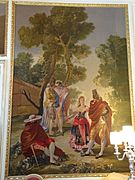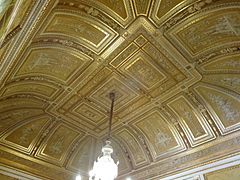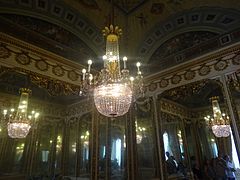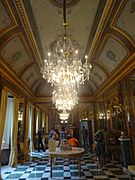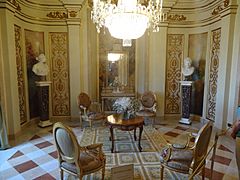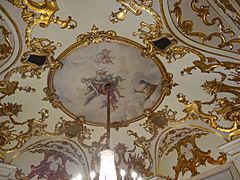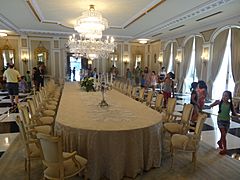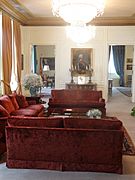Palace of Albéniz facts for kids
Quick facts for kids Albéniz Palace |
|
|---|---|
|
Spanish: Palacete Albéniz
Catalan: Palauet Albéniz |
|
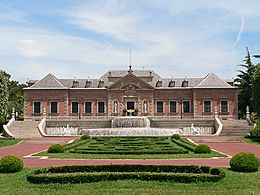
Rear facade of the palace
|
|
| General information | |
| Architectural style | Historicism, neo-Herrerian |
| Town or city | Barcelona |
| Country | Spain |
| Coordinates | 41°22′02″N 02°09′20″E / 41.36722°N 2.15556°E |
| Construction started | 1928 |
| Completed | 1928 |
| Client | Spanish royal family |
| Owner | City Council of Barcelona |
| Management | Patrimonio Nacional |
| Design and construction | |
| Architect | Juan Moya Idígoras |
The Albéniz Palace (also known as Palacete Albéniz or Palauet Albéniz) is a beautiful building in Barcelona, Spain. It sits on Montjuïc mountain. Today, it is the official home for the Spanish royal family when they visit Catalonia.
This palace has changed over time to fit different needs. First, it was used by the Spanish royal family during a big event in 1929. Later, it hosted important guests. Now, it is the royal family's main residence in the region.
Contents
History
The 1929 Exposition
The Albéniz Palace was built for the International Exposition in Barcelona in 1929. Many people think it was the royal family's home during the event. But actually, it was a place for the Royal Household to welcome guests.
The royal family used it to rest, have light meals, and meet important visitors. During the Exposition, King Alfonso XIII and Queen Victoria Eugenia stayed at the Royal Palace of Pedralbes.
Juan Moya Idígoras, the architect for the Royal House, designed the palace. Its style was different from other buildings at the Exposition. It looked more like the traditional palaces of the Bourbon royal family.
The palace officially opened on October 5, 1929. King Alfonso XIII and Queen Victoria Eugenia were there.
After the Exposition
After the Exposition ended in 1930, there was an idea to make the palace a music museum. This plan did not happen. However, a bust (a sculpture of a head and shoulders) of the famous musician Isaac Albéniz was placed there. From then on, the palace became known as the Palacete Albéniz.
The palace was closed during the Second Republic and the Civil War. In 1952, it was used to host Cardinal Angelo Dell'Acqua. He was a special guest for a big religious meeting in Barcelona.
In 1957, the mayor of Barcelona, Josep Maria de Porcioles i Colomer, decided to use the palace for important visitors. Many famous people stayed there, including Prince Constantine of Greece and Richard Nixon.
From 1965 to 1970, the Barcelona City Council decided to make the palace bigger. They added two new parts, changing its shape from a square to a "T".
The mayor also wanted the inside to be decorated with art from famous Catalan artists. These included Ramón Martí Alsina and Ramón Casas. Furniture from a famous collector, Luis Plandiura, was also added. A special dome was created with paintings by Salvador Dalí. These paintings show Barcelona's culture and city life. Another dome had a beautiful stained glass window.
The gardens around the palace were also made larger. They were named Joan Maragall gardens, after a Spanish poet. The newly expanded palace opened on June 23, 1970.
The first guests in the renovated palace were Prince Juan Carlos de Borbón and Princess Sofía de Grecia in 1971. After they became King and Queen in 1975, they chose the Albéniz Palace as their official home in Barcelona. Their son, King Felipe VI, and his wife, Queen Letizia, also prefer to stay at Albéniz.
The Palace
The palace is built with brick and stone around its windows, doors, and corners. Its roofs are made of slate. The outside of the palace looks a lot like Herrerian architecture. This style can be seen in other famous Spanish palaces.
The original design of the palace was a square shape. This was inspired by other royal buildings like the Palace of Zarzuela. Even with all the changes and additions, the palace still keeps its original look.
For the 1929 Exposition, the inside of the palace was decorated with old armors and beautiful tapestries. Some of these tapestries were made from designs by the famous artist Goya. Many rooms looked like copies of rooms in other royal palaces. In the 1960s, more paintings by local artists were added. These included works by Martí Alsina and Casas.
Interior
You enter the palace through a large wrought iron gate. It has a royal coat of arms on top. Two lion statues from the Royal Palace of Pedralbes stand on each side. The rooms inside are from two different building periods.
Old rooms
These rooms are part of the original square building from the 1929 Exposition.
- Entrance hall: The most amazing part here is the dome painted by Dalí in the 1960s. It shows a dance called the sardana. It also includes references to the first man on the moon, the Montserrat mountain, and the Sagrada Familia. Sculptures of important figures like Ramon Llull and Christopher Columbus are on the dome's supports.
- Hall of Goya or Tapestries: This room is like some rooms in the Royal Palace of El Pardo. It is named for its tapestries. These tapestries were woven from Goya's designs.
- Yellow Hall or Ramón Casas Hall: This room was once a dining room. It is a copy of the Yellow Hall in the Casita del Príncipe. Look for the detailed ceiling and the paintings by Ramón Casas.
- Hall of Mirrors: This small room and its furniture copy the King's Dressing Room in the Royal Palace of Aranjuez.
- Official Office: All the furniture here, like chairs and desks, has beautiful patterns made from different woods. These pieces are from a famous collection. The palace's guest book is kept in this room.
- Corridor: This used to be the back exit. Now, it connects the old and new parts of the palace.
- Golden Room: This room looks very rich. It has marble that looks like agate and golden decorations. It has chandeliers (fancy lights) held up by statues. There is also a 17th-century cabinet with ivory designs.
- Hall of the Busts: This room is named for the four busts in its corners. They show Roman emperors and goddesses like Diana and Selene. The ceiling is inspired by those made during the time of Felipe V.
- Circus: This room is in the middle of the palace. It has Italian marble and 18th-century tapestries. The most striking feature is the dome made of colorful glass. It was designed in the 1960s and shows a sardana dance.
New rooms
These are the two new parts added to the palace between 1965 and 1970. One holds the Gala Dining Room, and the other is the "residential section" for the royal family.
- Gala Dining Room: This is the biggest room in the palace. It has furniture in the Carlos IV style.
- Rear Lobby: This room is covered in marble. It leads to the garden and connects to the private living areas.
- Private Sitting Room: This room was once wood-colored but is now white. A portrait of Carlos III hangs between two doors.
- Lacquer Room: This small room gets its name from an old screen from the 1929 Exposition. It also has a fancy chest of drawers.
- Private Dining Room: This room has a neoclassical table from the old palace. It also features furniture in the Louis XIV style and paintings by artists like Vayreda.
- Library: The most notable piece here is a special desk from the 1888 Barcelona Universal Exposition.
- Bedrooms: The private living area includes several bedrooms. These are the porcelain room, a hall, the main bedroom, a dressing room, and a bedroom for an aide-de-camp (a military assistant).
Joan Maragall gardens
The gardens around the palace are named after the Spanish poet Joan Maragall. Other gardens in the Montjuïc area are also named after poets. The first gardens were designed by Jean-Claude Nicolas Forestier. They had a Mediterranean feel, with classic styles, pergolas (shaded walkways), and terraces.
In the 1970s, the gardens were made much larger. This was because the future King Juan Carlos I preferred the Albéniz Palace over the Palau Reial de Pedralbes. The new design was in a French style, with many sculptures.
The gardens have three main areas:
- One area is in front of the palace. It has two ponds and flowerbeds. There is also a small temple with a sculpture called Susanna in the Bath.
- Another area is on the sides of the palace. This is where the original 1929 gardens were. You can see two fountains with tritons (sea gods) and two sculptures of a Reclining Woman.
- The northern area looks towards the Palau Nacional (a large museum). Here, you'll find a courtyard with columns and a sculpture called Serena. The chapel of Santa Madrona is also located here.
See also
 In Spanish: Palacete Albéniz para niños
In Spanish: Palacete Albéniz para niños


